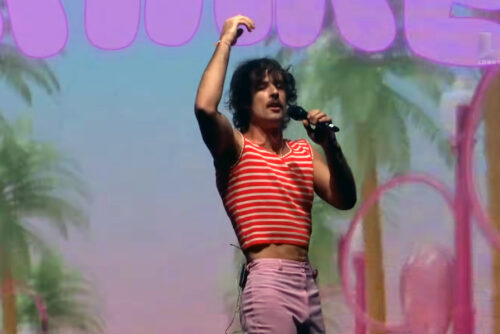This rehearsal morning is about red and white, eye masks, lunar modules and catsuits. Today we start the rehearsals of the second semifinal. We tell you everything we know about the first 4 countries in this article.
EBU has decided to release photo’s of it only the day after. But still we can show you (if available) the national final performance or any other live performance so you got an idea what the artists are capable of. Disclaimer: for the description of the performance, we have to do it with what the EBU tells us.
🇦🇺 Australia
Australia’s Go-Jo opens Day 3 of rehearsals with Milkshake Man, performed by artist Marty Zambotto. The staging begins with a retro-style infomercial, setting the tone for a performance rooted in 1970s and 1980s aesthetics. Go-Jo wears a white suit with a red-striped collar and cravat, accompanied by two dancers in red and white striped dresses. The LED graphics follow the theme of the official video, featuring bold neon visuals and nostalgic styling. A keytar solo is included mid-song. Toward the end, the LED screen and stage lighting shift into bright pinks and lasers. A large central prop plays a visual role, though its full details remain under wraps. The performance includes coordinated graphics for broadcast and dynamic stage movement throughout.
🇲🇪 Montenegro
Montenegro’s Nina Žižić returns to the Eurovision stage in 2025 with Dobrodošli, marking her first solo appearance since performing alongside Who See in 2013. At the start of the performance, she appears in a white structured dress featuring a large circular frame that extends from above her head to below her knees. Additionally, she wears a white eye mask, which she removes at the bridge leading into the first chorus. Her red lipstick stands out as the only contrasting colour in an otherwise monochrome palette. Meanwhile, the LED wall displays white light particles that gradually form swirling patterns. As the song progresses, blue and white lighting becomes more intense. Toward the end, Nina moves from centre stage to the frame stage for the final chorus. Finally, low white fog adds to the overall visual atmosphere.
🇮🇪 Ireland
Ireland’s rehearsal features Norwegian singer Emmy performing Laika Party, a Europop track inspired by the first dog in space. The staging opens with Emmy standing on a metallic platform shaped like a lunar module, under a spotlight. She wears a silver dress with a pleated skirt, silver boots, and a hood resembling a helmet. Her brother Erlend plays keyboards at stage level in front of her, dressed in a silver shirt and star-shaped sunglasses. Four female dancers in silver trousers and black vests join during each chorus. The LED wall displays neon planets and animated space cats timed to the song’s “bam bam” sections, with a constellation of Laika forming during the chorus. Firework jets are used in the final chorus.
🇱🇻 Latvia
Latvia’s Tautumeitas rehearse Bur Man Laimi, an ethno-pop entry performed entirely in Latvian. The group begins behind a semi-transparent curtain, which is used throughout the performance to create shadow effects and pockets of light. This staging element, retained from their Supernova performance, adds a sense of intimacy and atmosphere. The lighting design has been enhanced for the larger stage, with dramatic shifts in tone and intensity. At one point, the LED wall projects animated tails onto the performers, aligning precisely with their movements. The group now wears matching gold catsuits with branch- and fin-like detailing, as well as gold headdresses that illuminate and shift colour during the performance. Low fog is used throughout to heighten the mystical quality of the staging.



